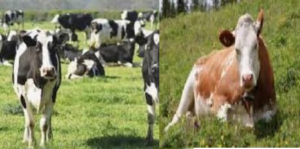A simple way of making and using high-quality compost in your backyard garden

A simple way of making and using high-quality compost in your backyard garden
Composting is a biological, chemical, and physical, highly aerobic process that transforms large, bulky, coarse materials (mostly plants and animal manures) into a homogenous, stable end product that is:
- uniform,
- brown/black,
- crumbly in texture (slightly greasy),
- sweet-smelling,
- and particulate.
Finished compost is a source of nutrients for plant growth and a feedstock for soil organisms.
The process is biological as it is achieved by organisms.
The actual decomposition is chemical via acids and enzymes.
The physical aspect involves macroorganisms (mostly arthropods) and their chewing, shredding, and mixing actions.
Compost can be used in two ways:
- As a soil builder/conditioner that improves the physical properties of soil (especially structure and bulk density),
- And as a fertilizer, with both immediate and long-term effects
Composting systems
Indore windrow method:
- The classic high-temperature aerobic composting method featuring animal manures and green waste was popularized by Sir Albert Howard.
- Growers and commercial producers use this method and its variations e.g., the Luebke method.
UC Rapid Composting:
- Features frequent turning of the pile (daily or every other day) to rapidly produce compost.
Sheet composting:
- Spreading and burying organic material (leaves, greens, etc.) over a garden bed or landscape, then digging it in to decompose.
- Additional nitrogen is sometimes applied.
Vermicomposting:
- Also known as worm composting, vermicomposting systems rely on earthworms to digest and decompose organic material, resulting in nutrient-rich “castings” used as a fertilizer and soil conditioner
In-vessel composting:
- Features a closed system such as a building or large metal containers in which temperature and airflow can be controlled.
- Often used to compost municipal wastes.
Advantages of aerobic hot composting process
- Stabilizes volatile nitrogen. Composted organic matter contains nitrogen in a more stable form (nitrate) that is more usable by plants.
- Recycles organic matter on farm and reduces off-farm inputs (nutrient cycling)
- Improves bulk density, a measurement of the weight of a volume of soil including both the solids and the pore space. In general, a lower bulk density number means better soil conditions. Bulk density increases with compaction; soils with a high bulk density can restrict root growth.
- Kills most pathogens, e.g., E. coli and Salmonella, and weed seeds (if piles are above 131˚F for 15 days)
- Introduces a wider population of microbes than found in the raw ingredients
- Reduces the volume of waste (by approximately 50%)
- Allows for use of raw materials that shouldn’t be put directly in soil (e.g., sawdust, raw manure)
- Degrades many contaminants since most pesticides are petroleum- (carbon)-based and thus digestible.
Possible disadvantages of composting
- Cost and time: Many farmers and gardeners don’t make their compost because of equipment needs, materials costs, and labour expenses.
- Space needed for composting can take up available production land
- Odor or other impacts on neighbours can create challenges in urban/suburban areas
- Rules governing compost production methods must be strictly followed if operating a certified organic farm.
Compost and the ecosystem (the role of organisms in compost building)
A wide range of decomposers are naturally present in most soils and on organic matter.
Microbial decomposers can account for 60%–80% of soil metabolism.
Decomposer organisms play different roles in a complex compost food web.
Microscopic organisms such as bacteria, fungi, actinomycetes, and yeasts are mostly primary consumers of compost materials.
Macroscopic organisms such as mold mites, nematodes, springtails, centipedes, beetles, and earthworms feed on the primary and secondary consumers.
Bacteria;
Bacteria are primarily responsible for the first stages of decomposition in the composting process
- Feed on succulent plant materials such as simple sugars, plant saps, proteins, and some starches.
- As their populations can double hourly, the initial rate of decomposition is rapid.
- Use primarily enzymes, manufactured from the Nitrogen-rich material in the pile, to decompose the organic matter.
Fungi;
- Also decompose simple sugars, plant saps, proteins, and starches, but their primary role is to decompose the most resistant carbonaceous compounds in the pile, such as chitin, lignin, and cellulose
- Improve soil structure by physically binding soil particles into aggregates
- Suppress disease
Actinomycetes;
- Filamentous bacteria, some of which grow as segmented hyphae (strands) that resemble fungi. Actinomycetes give compost its earthy smell.
- Produce long, greyish, thready, or cobweb-like growths that are most commonly seen toward the end of the composting process
- Can decompose complex carbon, including lignin, chitin, and cellulose. Enzymes enable them to break down woody stems, bark, and newspapers.
- Responsible for some disease suppression (produce enzymatic compounds and antibiotics)
Macro-organisms:
- Earthworms and other later compost pile immigrants.
- Though not always present in finished compost, macroorganisms feed on the pile’s earlier inhabitants
- Examples: Nematodes, mold mites, springtails, wolf spiders, centipedes, sow bugs, earthworms, and ground beetles.
Vital considerations in selecting materials to use to build your compost
Carbon-to-nitrogen (C: N) ratio;
- The carbon-to-nitrogen ratio refers to the proportion of carbon to nitrogen by weight in any organic matter. Different types of organic matter have different carbon-to-nitrogen or C: N ratios.
- For example, wood, which is very high in carbon, has a C: N ratio of 500:1 while grass clippings have a C: N ratio of 17:1.
- The C: N ratio of a material can change due to many factors: Plant growth, storage, how fertilized, and what an animal was fed.
- The optimum C: N ratio for biological activity is between 25:1 and 30:1.
- Compost piles should ideally start with an overall C: N ratio in this range.
- The C: N ratio of finished compost will be 14:1 to 17:1.
- Much of the carbon in the pile is released as CO2 as decomposers metabolize organic matter.
Nitrogenous materials
- Compost materials with low C: N ratios are often called nitrogenous, sometimes “greens”
- There is a range of nitrogenous materials as demonstrated on the C: N ratio charts.
- C: N ratio of a material can change:
- As a growing plant ages, it develops more carbon (e.g., young green grass growing into tall brownish-greenish stalks)
- Use greens when fresh.
- If necessary, make a concentric pile of greens; tarp to preserve N and use as soon as possible.
Carbon materials
- Compost materials with a high C: N ratio are called carbonaceous, sometimes “browns”
- Carbon materials can be more or less complex as shown on the C: N chart (e.g., wood chips can have a C: N ratio of 400:1, straw 70:1, brown leaves 40:1)
- High-carbon materials can be stored easily to use later (e.g., store brown leaves or straw stubble from fall to mix with the abundance of greens in the spring)
- Carbon materials can be bulkier and thus can provide aeration in a pile.
- High carbon materials often are dry and can be difficult to properly moisten (can be spread out and soaked or left out in rain).
Animal manures
- Manures are considered nitrogenous but can have a wide range of C: N ratios depending on the type of animal manure, feed source, bedding material, and age. For examples;
- Poultry manure (approximately 6 to 12:1 C: N ratio) is high in nitrogen as well as phosphorus
- Horse manure (approximately 20:1 C: N ratio) mixed with bedding material (straw or woodchips).
- Bedding absorbs urine well, and half the N is in urine, and half in manure.
- Manure can vary widely in its overall C: N ratio due to the type and quantity of bedding material (e.g., is the “horse manure” pile mostly dry wood shavings? Think high carbon).
- Although not particularly high in nutrients (other than K), it is a great “tool” for building soil structure, whereas chicken manure is a more effective fertilizer.
- In general, manures are more biologically active than plant residues due to having passed through an animal’s digestive system
- Raw manures can carry weed seeds, pathogens, pesticide residues, and antibiotics, so should be composted properly.
- If applied directly to the soil, National Organic Program regulations dictate raw (uncomposted) animal manures must be incorporated a minimum of 120 days before the harvest of crops “whose edible portion has direct contact with the soil surface or soil particles, (e.g., leafy greens) or 90 days before the harvest of crops with no direct soil surface or soil particle contact. “
Other materials to consider are;
Clay soil:
- Those who use the Luebke method of compost think it’s beneficial to use 10% clay soil in the pile because it reduces N losses, and makes the end-product more stable.
- Clay acts as a “colloidal trap,” retaining nitrogen where microbes can convert it from a gaseous form into a usable form.
- Thin, repetitive layers of clay soil work best.
Rock phosphate;
- It can increase usable phosphorus by making P more available to crops and help reduce the volatilization of NH3.
- By layering rock phosphate next to animal manures in a compost pile, the result is an increase in Pseudomonas spp. bacteria as well as nitrifying bacteria.
- These organisms immobilize both P and N in their bodies; when they die and decompose, those nutrients are liberated in a form available for plants to use.
Inoculants (purchased biological “activators”):
- May be useful for dealing with some problems, e.g., high oil content plant residues, but is considered unnecessary by most because compost organisms are present in manures, soils, and on plant materials.
- Some use aged compost as an inoculant if the composting area is new or on concrete.
Wood ash:
- Using small amounts of wood ash in compost eliminates possible negative effects of high pH of ash when added directly to the soil and adds potassium
Materials that are not to be composted
- Though often discouraged, composting manure of humans or other carnivorous or omnivorous animals (dogs, cats, pigs) is possible, but you must be very careful about pathogens. Food safety and organic certification regulations may prohibit the use of these materials in compost; check current guidelines.
- Perennial weeds that are resistant to decay such as Bermuda grass, oxalis, mint, bindweed
- Some diseased plants, e.g., fire blight on pear/apple wood, Phytophthora infections (late blight) on potatoes and tomatoes
- Meat and dairy (if worried about attracting pests). Small amounts are okay in the center of the pile.
- Large quantities of fats and oils: Compost organisms can’t readily break these down
- Leaves of eucalyptus, walnut, and other trees with tannins or known allelochemicals; conifers (acidic, slow to break down). Small amounts of these materials are okay.
Other valuable things to note in composting
- Shredding or chopping materials, especially large, woody stalks, will speed the composting
- The greater the surface area to volume ratio, the faster the rate of potential decomposition. Decomposers work on surfaces, so the more surfaces exposed, the more decomposers can work.
- Compaction can occur if the particle size is too small, and the material is wet and nitrogenous (e.g., all lawn clippings), leading to loss of aeration and anaerobic conditions
- Layering sequence and thickness can be adjusted to avoid compaction and maintain aeration; alternate large with small particle sizes
- Waxy-coated leaves decay very slowly because of the coated surface
The importance of moisture in compost production
Moisture needs of decomposers;
- All decomposers involved in composting need water.
- Aerobic microbes, similar to marine mammals, need water around them all the time but also need oxygen to survive.
- They live and move around on a film of water.
Moisture content in the compost pile should be 50%–60% (moist as a wrung-out sponge)
- First, consider the moisture of the materials to be composted
- Add water as the pile is built, watering dry layers especially.
- More water should be put on layers in the top half of the pile, as much will trickle down (apply approximately two-thirds in the top half, one-third in the bottom half).
- Excess moisture will cause compaction and loss of air (you shouldn’t be able to squeeze water out of compost)
- Insufficient moisture will cause a pile to decompose slowly
- If you’re going to turn a pile frequently, you can add more water as you turn
- Turn pile, troubleshoot, add water if too dry, aerate, and add dry material if too wet
- Seasonal moisture considerations are necessary. Tarp piles in winter to keep rain off; use compost covers, tarps, or straw caps to conserve moisture in summer.
The importance of aeration in compost production
- Aerobic bacteria, which make hot composting happen, require oxygen and respire carbon dioxide (CO2)
- Anaerobic bacteria populate portions of the pile where the oxygen content is low.
- They create methane gas and sulphur compounds (the rotten eggs smell) and can be harmful to soil life (commercial compost made in anaerobic digesters is often finished aerobically in windrows).
- Oxygen is often the limiting factor when compost temperature goes down after the first weeks
- CO2 can be monitored with special equipment—at 10–12% CO2, need to turn the pile if possible
- Turning the pile reintroduces oxygen, stimulating new growth of aerobic bacteria and further breaking down material, making it easier for microbes to decompose them.
- You can also break up anaerobic pockets within the pile as you turn it.
Maturation and Turning
Most windrow piles take about 6 months minimum (spring into fall) to mature if not turned; longer in winter depending on climate.
Note that National Organic Program (NOP) standards require that windrows be turned five times, and remain at a temperature between 131˚–170˚F for 15 days, for use on certified organic farms.
Be sure to check current regulations, as changes to these standards may occur.
Advantages of turning include:
- Speeds composting process by aerating the pile
- Achieves more thorough composting by moving outer materials to the pile center
- Allows for troubleshooting and adjustments to pile (great learning opportunity)
- Additional mixing of ingredients
- Physical (mechanical) breakdown of particle size of materials
Disadvantages of turning include:
- Time, energy, expense
- Loss of nitrogen as the pile is turned
- Additional space is needed unless turning out and back
- Turn at least once (more speedily process but is labour intensive by hand)
- If you turn compost only once, ideally do so at 3 weeks or when the temperature curve has started back down.
- After turning at this stage, the temperature curve will go up again.
- At this point, oxygen is the limiting factor reintroducing oxygen for aerobic organisms to continue using as they digest the still relatively fresh materials.
- If you turn the pile twice, ideally turn at about 3 weeks and 6 weeks, again referring to the heat curve for information
Determining Compost Maturity and Stability
- Parent material should be largely indistinguishable, texture should be crumbly
- Temperature has cooled down to ambient temperature
- Signs of macro life (e.g., redworms, sowbugs, springtails), though may not be present in large-scale operations
- Dark brown to blackish-brown colour
- Earthy smell (no ammonia or anaerobic odor)
- Feels “greasy” or slick when squeezed between fingers
Maturity vs. stability:
A set of 7 quantitative indicators is used to define the maturity and stability of compost;
- pH: 6.5 to 8.0
- Sulphides: zero to only trace
- Ammonia = <0.05 ppm
- Ammonium: 0.2 to 3.0 ppm
- Nitrites: <1.0 ppm
- Nitrates: <300 ppm
- CO: <1%
Applying Compost Consider
The Timing
- Spring, before planting
- Mid-season, as “side dress”: Placed around established plantings and worked into the top 1–4 inches of soil
- Fall, with a planting of cover crops
Application rates
- Application rates vary with the intensiveness of the cropping system and use of cover crops
- Field scale: ~4–10 tons/acre on an annual basis
- Garden scale: ~ 0.5–2 lbs/square foot (this = 10–20 tons/acre annually). 1–2 lbs/square foot for soil development, 0.5–1 lb/square foot for maintenance.
Placement
- Field-scale: Incorporate into the top 8–12 inches of soil
- Side dress: In the root zone of the crop
- Garden-scale
- Initial stages of soil development: Incorporate into top 12–24 inches of soil.
- Soil fertility maintenance: Incorporate into top 4–8 inches via side forking
Many growers buy commercially produced compost, and some make large volumes of compost on-site using a windrow system and compost turner or front-end loader
Advantages of making compost on-site
- Quality control: Can monitor and maintain control, ensure quality end product
- Effective use of culls, and other on-farm waste materials that would otherwise have to be disposed of
- Compost is available when needed; commercial supplies are not always available
- Potential cost savings in making compost on-site vs. buying from a commercial source
- A key part of the soil health and fertility program; high-quality compost helps ensure healthy soil
Challenges of making compost on-site
- Up-front costs for equipment such as compost turner, appropriate tractor/bucket loader, irrigation infrastructure, etc. can be high
- The learning curve involved: May take several years of fine-tuning the system to ensure reliable results
- Requires reliable sources of quality feedstocks, e.g., green waste, and manure. Materials and delivery costs can be high.
- Requires labour inputs
- Requires dedicated space for delivery of feedstock and windrowing
- Requires water source
- Must comply with local and state ordinances and regulations: leachates, odors, other considerations
- Certified organic operations must meet federal National Organic Program regulations; weather conditions (e.g., extended rainy periods), labour, and time constraints can make requirements for 5 pile turnings in 15 days challenging.
Recommendations for “buying in” compost from commercial producers
- Monitor quality; ask for records of inputs and nutrient analysis
- Visit the composting operation to inspect materials, practices used
- If certified organic, make sure the product is approved by the Organic Materials Review Institute.
- Ensure adequate space available for deliveries









Your article on [specific topic] provided an exceptional blend of clear structure and thoughtful advice that truly stood out. The organization of your content was impressive,